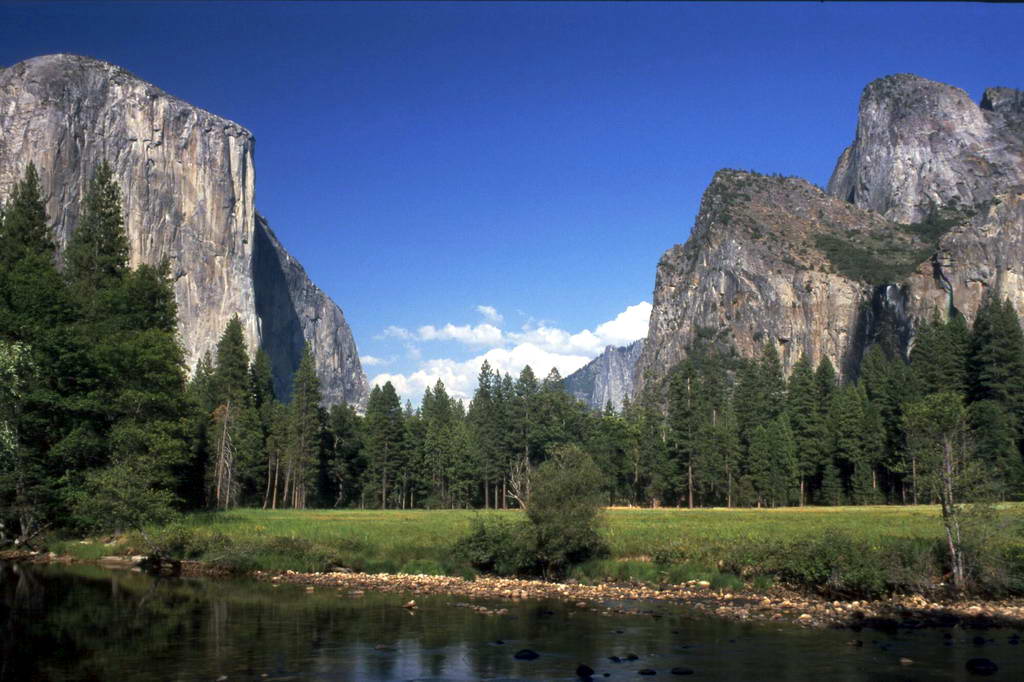 Yosemite National Park is located in the eastern portions of Tuolumne, Mariposa and Madera counties in east central California. The park covers an area of 3 081 km² and reaches across the western slopes of the Sierra Nevada mountain chain. Yosemite is visited by over 3.5 million people each year. Designated a World Heritage Site in 1984, Yosemite is internationally recognized for its spectacular granite cliffs, waterfalls, clear streams, Giant Sequoia groves, and biological diversity.
Yosemite National Park is located in the eastern portions of Tuolumne, Mariposa and Madera counties in east central California. The park covers an area of 3 081 km² and reaches across the western slopes of the Sierra Nevada mountain chain. Yosemite is visited by over 3.5 million people each year. Designated a World Heritage Site in 1984, Yosemite is internationally recognized for its spectacular granite cliffs, waterfalls, clear streams, Giant Sequoia groves, and biological diversity. Yosemite Valley represents only one percent of the park area, but this is where most visitors arrive and stay. El Capitan, a prominent granite cliff that looms over the valley, is one of the most popular rock climbing destinations in the world because of its diverse range of climbing routes in addition to its year-round accessibility. Granite domes such as Sentinel Rock and Half Dome rise 900 and 1,450 m above the valley floor. Complete list of Yosemite's Best Free Climbing Routes could be found here.
El Capitan is a 910 m vertical rock formation, located on the north side of Yosemite Valley, near its western end. The granite monolith is one of the world's favorite challenges for rock climbers.
The formation was named "El Capitan" by the Mariposa Battalion when it explored the valley in 1851. El Capitan ("the captain", "the chief") was taken to be a loose Spanish translation of the local Native American name for the cliff, variously transcribed as "To-to-kon oo-lah" or "To-tock-ah-noo-lah". It is unclear if the Native American name referred to a specific Tribal chief, or simply meant "the chief" or "rock chief". In modern times, the formation's name is often contracted to "El Cap", especially among rock climbers.
El Capitan, or El Cap, has two faces: the Southwest and the Southeast. Between the two faces is a protruding shelf called The Nose. The Nose is the most popular and famous route by which to climb El Capitan. The Nose was first climbed in 1958 by Warren J. Harding, Wayne Marry, and George Whitmore in 47 days. They used “siege” tactics, which meant using fixed ropes along the length of the route and establishing camps. The second ascent in 1960 took 7 days. The first single day ascent was accomplished in 1975. Presently, The Nose challenges climbers of all experience levels. Some of the earliest routes for climbing El Capitan are still the favorites; Salathe Wall on the southwest face, and the North America Wall on the southeast face, both climbed in the 60s. Other early routes include Dihedral Wall, West Buttress, and Muir Wall. Later climbs involve routes like the Wall of Early Morning Light, Zodiac, Mescalito, the Sea of Dreams, the Shield, the Pacific Ocean Wall, and the Jolly Roger. Today there are over 70 routes going up El Capitan, many of which link old routes and new ones. With that many routes, there is something to appeal to every level of experience and ability.
Climbing the Nose in June 2007 - Konrad Schlenkrich & Livio Urban & Thomas Johne (Germany)
Ascent of Zodiac (VI, 5.8, A3) on Yosemite's El Capitan.
Half Dome is a granite dome, located at the eastern end of Yosemite Valley — possibly Yosemite's most familiar sight. The granite crest rises more than 1 444 m above the valley floor.
As late as the 1870s, Half Dome was declared "perfectly inaccessible", but it may now be ascended in several different ways. Thousands of hikers reach the top each year by following a trail from the valley floor. The trailhead is only 3.2 km from Half Dome itself, but the circuitous route is 13.7 km long. The final ascent is accomplished by following a pair of metal cables raised on posts up the peak's steep but somewhat rounded east face. The cable route was constructed in 1919, but followed close to the route of George Anderson's October, 1875 first ascent made by drilling iron eyebolts into the smooth granite.
Alternatively, over a dozen rock climbing routes lead from the valley up Half Dome's vertical northwest face. Other routes ascend the south face and the west shoulder. The first modern technical route was the Regular Northwest Face route - originally climbed in 1957 by Royal Robbins, Mike Sherrick, and Jerry Gallwas. This 5-day ascent was the first Grade VI climb in the United States.
VIDEO-HIKE part of the Half Dome trail.
Used information, pictures and video from http://en.wikipedia.org/, http://www.extranomical.com/ and http://www.youtube.com/




Няма коментари:
Публикуване на коментар